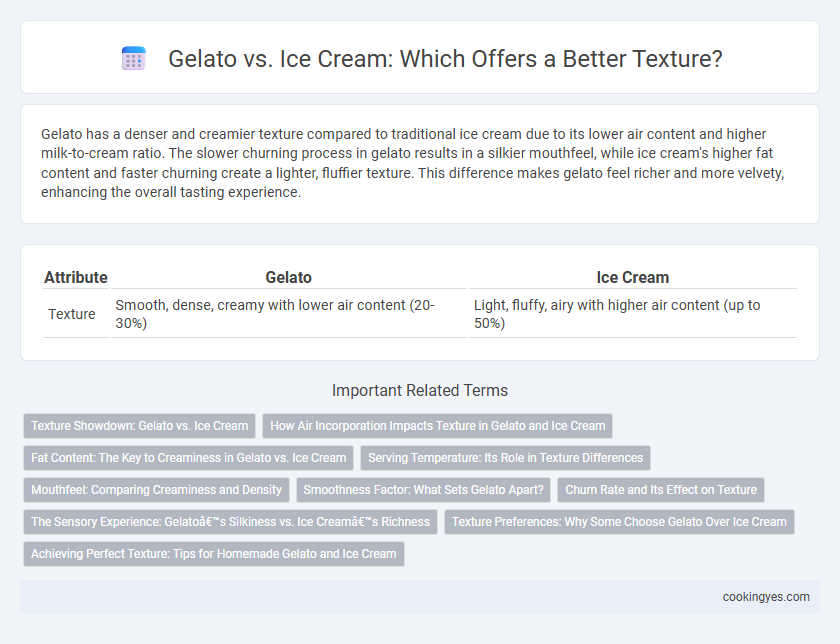Gelato has a denser and creamier texture compared to traditional ice cream due to its lower air content and higher milk-to-cream ratio. The slower churning process in gelato results in a silkier mouthfeel, while ice cream's higher fat content and faster churning create a lighter, fluffier texture. This difference makes gelato feel richer and more velvety, enhancing the overall tasting experience.
Table of Comparison
| Attribute | Gelato | Ice Cream |
|---|---|---|
| Texture | Smooth, dense, creamy with lower air content (20-30%) | Light, fluffy, airy with higher air content (up to 50%) |
Texture Showdown: Gelato vs. Ice Cream
Gelato boasts a denser and silkier texture achieved by churning at a slower speed, incorporating less air than traditional ice cream. Ice cream's higher overrun results in a lighter and fluffier consistency with more air pockets. This texture showdown highlights gelato's creamy melt-in-the-mouth experience versus ice cream's airy, scoopable smoothness.
How Air Incorporation Impacts Texture in Gelato and Ice Cream
Gelato contains significantly less air, typically 20-30% overrun, resulting in a denser and creamier texture compared to traditional ice cream, which can have up to 50% or more overrun. This lower air incorporation in gelato emphasizes intense flavor and smooth consistency, while higher air content in ice cream creates a lighter, fluffier mouthfeel. The difference in churning speeds and temperature during production directly influences the amount of air whipped into the final product, defining the distinctive textures of gelato versus ice cream.
Fat Content: The Key to Creaminess in Gelato vs. Ice Cream
Gelato typically contains 4-8% fat, significantly lower than traditional ice cream's 10-18%, which directly impacts the creaminess and mouthfeel. The reduced fat content in gelato allows for more intense flavors as it doesn't coat the palate as heavily as ice cream, while the slower churning process incorporates less air, resulting in a denser texture. Ice cream's higher fat content contributes to a richer, creamier texture, but also creates a smoother, silkier sensation compared to gelato's more velvety and elastic consistency.
Serving Temperature: Its Role in Texture Differences
Gelato is served at a slightly warmer temperature than ice cream, typically around 10-15degF warmer, which enhances its softer, silkier texture. This higher serving temperature reduces the hardening of fats, allowing gelato to maintain a dense yet creamy mouthfeel. In contrast, ice cream's colder serving temperature preserves its firmer, more aerated structure, contributing to a more solid bite.
Mouthfeel: Comparing Creaminess and Density
Gelato features a lower fat content and slower churning process, resulting in a denser, creamier texture with less air incorporated compared to traditional ice cream. This increased density enhances the mouthfeel, allowing flavors to linger more intensely on the palate. Ice cream, with higher fat content and more air whipped in, offers a lighter, fluffier texture that feels colder and more refreshing but less rich in creaminess.
Smoothness Factor: What Sets Gelato Apart?
Gelato boasts a denser, silkier texture due to its lower air content, known as overrun, typically around 20-30%, compared to ice cream's 50% or more. This reduced air content amplifies the smoothness factor, creating a creamier, more velvety mouthfeel unique to gelato. The slower churning process and warmer serving temperature further enhance gelato's distinctively smooth and rich texture.
Churn Rate and Its Effect on Texture
Gelato typically has a lower churn rate compared to ice cream, resulting in less air being incorporated into the mixture. This lower overrun creates a denser, creamier texture that highlights the intense flavors of natural ingredients. Ice cream's higher churn rate introduces more air, making it lighter and fluffier but less rich in texture than gelato.
The Sensory Experience: Gelato’s Silkiness vs. Ice Cream’s Richness
Gelato offers a uniquely silky texture due to its lower fat content and slower churning process, which incorporates less air, resulting in a denser, creamier mouthfeel. Ice cream delivers a richer sensation with higher butterfat levels and more air, creating a fluffier and more indulgent texture. The sensory experience of gelato emphasizes smoothness and intensity of flavor, while ice cream highlights a creamy, luscious richness that coats the palate.
Texture Preferences: Why Some Choose Gelato Over Ice Cream
Gelato features a denser, creamier texture due to its lower air content and higher milk-to-cream ratio, appealing to those who prefer a silkier mouthfeel. Ice cream incorporates more air through churning, resulting in a lighter, fluffier consistency favored by consumers who enjoy a softer, more voluminous treat. Texture preferences often drive the choice between gelato and ice cream, as gelato's rich smoothness contrasts with ice cream's airy composition.
Achieving Perfect Texture: Tips for Homemade Gelato and Ice Cream
Gelato achieves a denser, creamier texture due to its lower overrun and higher milk-to-cream ratio, while ice cream is lighter and airier from increased churning and overrun. To perfect homemade gelato texture, maintain a lower serving temperature around 10degF (-12degC) and use fresh whole milk with a small amount of cream for smoothness. For ice cream, incorporate more cream and churn at a faster speed to maximize air incorporation, ensuring a fluffy yet creamy consistency.
Gelato vs Ice Cream for Texture Infographic

 cookingyes.com
cookingyes.com